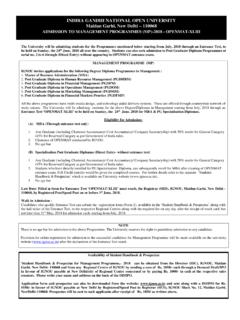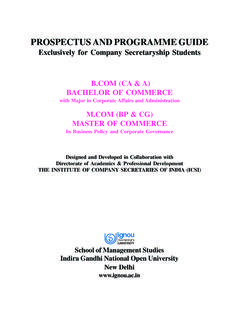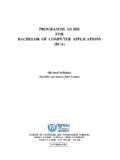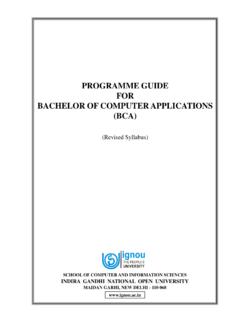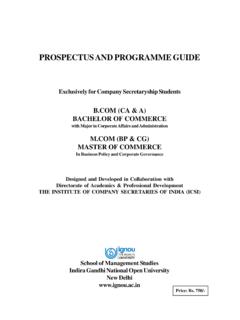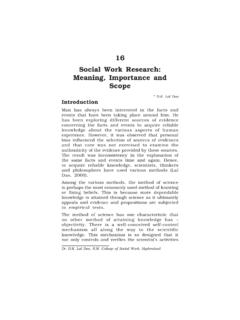Transcription of UNIT 4 REFRIGERANTS - IGNOU
1 unit 4 REFRIGERANTS Structure Introduction Objectives Primary and Secondary REFRIGERANTS Classification of REFRIGERANTS Designation of REFRIGERANTS Desirable Properties of REFRIGERANTS Thermodynamic Properties Chemical Properties Physical Properties Safety Criteria Economic Criteria Common REFRIGERANTS Ozone Depletion Potential and Global Warming Potential Secondary REFRIGERANTS Illustrative Problems Summary Answers to SAQs INTRODUCTION The working agent in a refrigerating system that absorbs carries or releases heat from the place to be cooled or refrigerated can be termed as a refrigerant . This heat transfer generally takes place through a phase change of the refrigerant .
2 A more complete definition of a refrigerant could be given as follows: refrigerant is the fluid used for heat transfer in a refrigerating system that absorbs heat during evaporation from the region of low temperature and pressure, and releases heat during condensation at a region of higher temperature and pressure. Objectives In this unit , we shall learn about the different REFRIGERANTS used in various refrigeration systems. At present, we have a large number of REFRIGERANTS available to us depending on the requirements of the particular refrigerating system. A detailed study of these REFRIGERANTS has thus become imperative. This unit is intended to serve as an introductory guide to the study of REFRIGERANTS .
3 After studying this unit , you should be able to learn the different classifications of REFRIGERANTS , naming convention for REFRIGERANTS , properties of individual REFRIGERANTS , and environmental effects related to the use of these REFRIGERANTS . 54 Refrigeration and Air Conditioning PRIMARY AND SECONDARY REFRIGERANTS Primary REFRIGERANTS are those which can be directly used for the purpose of refrigeration. If the refrigerant is allowed to flow freely into the space to be refrigerated and there is no danger of possible harm to human beings, then primary REFRIGERANTS are used. The REFRIGERANTS used in home refrigerators like Freon-12 are primary REFRIGERANTS .
4 On the other hand, there may be certain situations in which we cannot allow the refrigerant to come in direct contact with the items being refrigerated, and then the refrigerant used is termed as a secondary refrigerant . As for example, we cannot allow a toxic refrigerant to be used for air conditioning in residential buildings. There are some REFRIGERANTS which are highly inflammable and so their direct use is forbidden for safety reasons. Again, it may so happen that if direct refrigeration, such as in cooling a big cold storage, is allowed, then the amount of refrigerant required may be so large that its cost becomes prohibitively high. These are some typical situations for which we favour the use of secondary REFRIGERANTS .
5 Water and brine solutions are common examples of secondary REFRIGERANTS . CLASSIFICATION OF REFRIGERANTS REFRIGERANTS can be broadly classified based on the following: Working Principle Under this heading, we have the primary or common REFRIGERANTS and the secondary REFRIGERANTS . The primary REFRIGERANTS are those that pass through the processes of compression, cooling or condensation, expansion and evaporation or warming up during cyclic processes. Ammonia, R12, R22, carbon dioxide come under this class of REFRIGERANTS . On the other hand, the medium which does not go through the cyclic processes in a refrigeration system and is only used as a medium for heat transfer are referred to as secondary REFRIGERANTS .
6 Water, brine solutions of sodium chloride and calcium chloride come under this category. Safety Considerations Under this heading, we have the following three sub-divisions. Safe REFRIGERANTS These are the non-toxic, non-flammable REFRIGERANTS such as R11, R12, R13, R14, R21, R22, R113, R114, methyl chloride, carbon dioxide, water etc. Toxic and moderately flammable Dichloroethylene methyl format, ethylchloride, sulphur dioxide, ammonia etc. come under this category. Highly flammable REFRIGERANTS The REFRIGERANTS under this category are butane, isobutene, propane, ethane, methane, ethylene etc. Chemical Compositions They are further sub-divided as 55 REFRIGERANTS Halocarbon compounds These are obtained by replacing one or more hydrogen atoms in ethane or methane with halogens.
7 Azeotropes These are the mixtures of two or more REFRIGERANTS and behave as a compound. Oxygen and Nitrogen Compounds REFRIGERANTS having either oxygen or nitrogen molecules in their structure, such as ammonia, are grouped separately and have a separate nomenclature from the halogenated REFRIGERANTS . Cyclic organic Compounds The compounds coming under this class are R316, R317 and R318. Inorganic Compounds These are further divided into two categories: Cryogenic and Non-cryogenic. Cryogenic fluids are those which are applied for achieving temperatures as low as 160 0C to 273 0C. Above this temperature range, we can use a multi-stage refrigeration system to realise the desired temperature.
8 But below 160 0C, this is not possible since the COP of the cycle becomes very low. To attain temperatures below 160 0C, we use REFRIGERANTS such as nitrogen, oxygen, helium, hydrogen etc. and for temperatures close to 273 0C, magnetic cooling is employed. The inorganic compounds which are employed above the cryogenic temperature ranges come under the remaining sub-division of inorganic REFRIGERANTS . Unsaturated Compounds Compounds such as ethylene, propylene etc. are grouped under this head and grouped under the 1000 series for convenience. Miscellaneous This group contains those compounds which cannot be grouped under the other components. They are indicated by the 700 series with the last numbers being their molecular weight.
9 Examples include air, carbon dioxide, sulphur dioxide etc. As we can see from the above sub-divisions, they are not mutually exclusive. A compound may come under more than one sub-division. Hence, the importance of adopting the various naming conventions to designate the different REFRIGERANTS cannot be underestimated. DESIGNATION OF REFRIGERANTS The American Society of Refrigerating Engineers (ASRE) has developed certain conventions for use in naming different types of REFRIGERANTS . These naming conventions differ according to the type of refrigerant . Each refrigerant type is denoted by a different series. Thus, we have separate series for halogenated REFRIGERANTS and other types.
10 The naming conventions are simple and easy to 56 Refrigeration and Air Conditioning follow. These conventions are now accepted worldwide and help to name the large variety of REFRIGERANTS available commercially nowadays. Halocarbon Compounds These are represented by a three digit nomenclature. Here, the first digit represents the number of carbon atoms in the compound minus one, the second digit stands for the number of hydrogen atoms plus one while the third digit stands for the number of fluorine atoms. The remaining atoms are chlorine. As an example, let us consider the refrigerant having R22 as its three digit nomenclature. According to the above mentioned convention, No.
